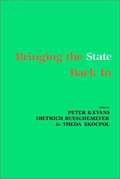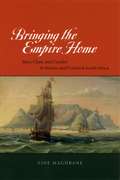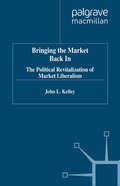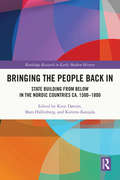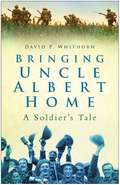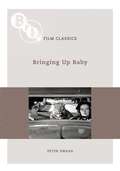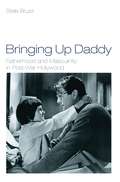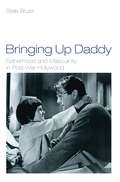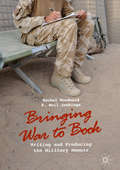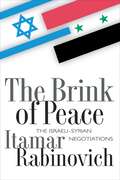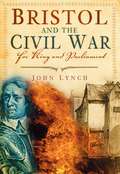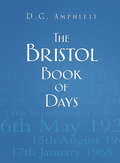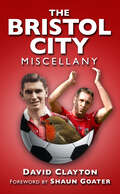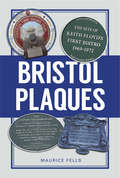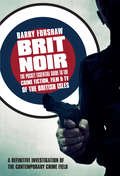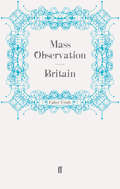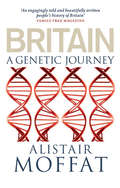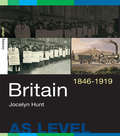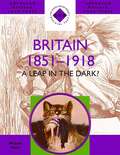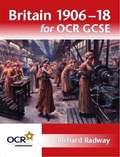- Table View
- List View
Bringing The State Back In (PDF)
by Peter Evans Dietrich Rueschemeyer Theda SkocpolUntil recently, dominant theoretical paradigms in the comparative social sciences did not highlight states as organizational structures or as potentially autonomous actors. Indeed, the term 'state' was rarely used. Current work, however, increasingly views the state as an agent which, although influenced by the society that surrounds it, also shapes social and political processes. The contributors to this volume, which includes some of the best recent interdisciplinary scholarship on states in relation to social structures, make use of theoretically engaged comparative and historical investigations to provide improved conceptualizations of states and how they operate. Each of the book's major parts presents a related set of analytical issues about modern states, which are explored in the context of a wide range of times and places, both contemporary and historical, and in developing and advanced-industrial nations. The first part examines state strategies in newly developing countries. The second part analyzes war making and state making in early modern Europe, and discusses states in relation to the post-World War II international economy. The third part pursues new insights into how states influence political cleavages and collective action. In the final chapter, the editors bring together the questions raised by the contributors and suggest tentative conclusions that emerge from an overview of all the articles. As a programmatic work that proposes new directions for the analysis of modern states, the volume will appeal to a wide range of teachers and students of political science, political economy, sociology, history, and anthropology.
Bringing the Empire Home: Race, Class, and Gender in Britain and Colonial South Africa
by Zine MagubaneHow did South Africans become black? How did the idea of blackness influence conceptions of disadvantaged groups in England such as women and the poor, and vice versa? Bringing the Empire Home tracks colonial images of blackness from South Africa to England and back again to answer questions such as these. Before the mid-1800s, black Africans were considered savage to the extent that their plight mirrored England's internal Others—women, the poor, and the Irish. By the 1900s, England's minority groups were being defined in relation to stereotypes of black South Africans. These stereotypes, in turn, were used to justify both new capitalist class and gender hierarchies in England and the subhuman treatment of blacks in South Africa. Bearing this in mind, Zine Magubane considers how marginalized groups in both countries responded to these racialized representations. Revealing the often overlooked links among ideologies of race, class, and gender, Bringing the Empire Home demonstrates how much black Africans taught the English about what it meant to be white, poor, or female.
Bringing the Market Back in: The Political Revitalization of Market Liberalism
by J. KelleyThis timely volume tells the fascinating story of how an almost forgotten classical liberalism resuscitated itself in America. Using educational institutions, think-tanks, foundations and the Libertarian Party, market liberals capitalized on the post-1969 crisis of Great Society liberalism to promote an alternate vision. Despite Ronald Reagan's anti-government rhetoric, the activist state survived because market liberals remained a minority, albeit a vocal one. Kelley argues that the recent 'Gingrich Revolution' will fail for the same reason. Although remaining profoundly skeptical about the modern state, Americans have yet to be persuaded by F.A. Hayek's vision of a classical liberal utopia.
Bringing the People Back In: State Building from Below in the Nordic Countries ca. 1500-1800
by Knut Dørum Mats Hallenberg Kimmo KatajalaThe formation of states in early modern Europe has long been an important topic for historical analysis. Traditionally, the political and military struggles of kings and rulers were the favoured object of study for academic historians. This book highlights new historical research from Europe’s northern frontier, bringing ‘the people’ back into the discussion of state politics, presenting alternative views of political and social relations in the Nordic countries before industrialisation. The early modern period was a time that witnessed initiatives from people from many groups formally excluded from political influence, operating outside the structures of central government, and this book returns to the subject of contentious politics and state building from below.
Bringing the People Back In: State Building from Below in the Nordic Countries ca. 1500-1800
by Knut Dørum Mats Hallenberg Kimmo KatajalaThe formation of states in early modern Europe has long been an important topic for historical analysis. Traditionally, the political and military struggles of kings and rulers were the favoured object of study for academic historians. This book highlights new historical research from Europe’s northern frontier, bringing ‘the people’ back into the discussion of state politics, presenting alternative views of political and social relations in the Nordic countries before industrialisation. The early modern period was a time that witnessed initiatives from people from many groups formally excluded from political influence, operating outside the structures of central government, and this book returns to the subject of contentious politics and state building from below.
Bringing Uncle Albert Home: A Soldier's Tale
by David P WhithornPrivate Albert Turley, an ordinary British soldier of the First World War, died on the Somme for King and Country. Like thousands more soldiers, he left neither letters nor diaries from which to reconstruct his story. This book focuses on the history of the 3rd Worcestershire, his regiment, and reveals what happened to Private Albert Turley.
Bringing Up Baby (BFI Film Classics)
by Peter SwaabBringing Up Baby, directed by Howard Hawks in 1938, is one of the greatest screwball comedies and a treasure from the Golden Age of Hollywood. Cary Grant plays a naive and repressed palaeosaurologist who becomes entangled with (and ensnared by) a wilful heiress (Katharine Hepburn). Chaos ensues as romance blossoms and not one but two leopards are set loose in verdant Connecticut. All of Hawks's signature skills are to the fore: there is the wonderful ensemble cast, the characteristically refined but unselfconscious visual style, an endless succession of pratfalls, innuendo and jokes (written by Dudley Nichols and Hagar Wilde) and, underneath the chaos and good cheer, a serious dream of escaping life's troubles by dint of nothing more or less than nerve and luck. There are no human babies in Bringing Up Baby, but there are those leopards and the relentless terrier George – and, as Peter Swaab explores in his witty and original study, Hawks's film wonders profoundly why we want animals in our lives and why we sometimes need to behave as animals ourselves. Many screwball films have been seen as comedies of remarriage, but Peter Swaab argues that this one is not much interested in marriage and is instead more captivated by instinct, irresponsibility and the wild abnormalities of romance. The film is in its way an American dream of independence, and believes the real way to get on in life – for film-makers as well as scientists – isn't by deference and respectability but by having sexy fun with the right people. A thoroughly American fiction of the 1930s, Bringing Up Baby is also a timelessly classical comic narrative, exploring conflicts between civilisation and nature, rationality and insanity, middle-class inhibitions and aristocratic blitheness. And it is the epitome of film comedy, an anthology of comic types and devices, and one of the most seductively funny films ever made.
Bringing Up Baby (BFI Film Classics)
by Peter SwaabBringing Up Baby, directed by Howard Hawks in 1938, is one of the greatest screwball comedies and a treasure from the Golden Age of Hollywood. Cary Grant plays a naive and repressed palaeosaurologist who becomes entangled with (and ensnared by) a wilful heiress (Katharine Hepburn). Chaos ensues as romance blossoms and not one but two leopards are set loose in verdant Connecticut. All of Hawks's signature skills are to the fore: there is the wonderful ensemble cast, the characteristically refined but unselfconscious visual style, an endless succession of pratfalls, innuendo and jokes (written by Dudley Nichols and Hagar Wilde) and, underneath the chaos and good cheer, a serious dream of escaping life's troubles by dint of nothing more or less than nerve and luck. There are no human babies in Bringing Up Baby, but there are those leopards and the relentless terrier George – and, as Peter Swaab explores in his witty and original study, Hawks's film wonders profoundly why we want animals in our lives and why we sometimes need to behave as animals ourselves. Many screwball films have been seen as comedies of remarriage, but Peter Swaab argues that this one is not much interested in marriage and is instead more captivated by instinct, irresponsibility and the wild abnormalities of romance. The film is in its way an American dream of independence, and believes the real way to get on in life – for film-makers as well as scientists – isn't by deference and respectability but by having sexy fun with the right people. A thoroughly American fiction of the 1930s, Bringing Up Baby is also a timelessly classical comic narrative, exploring conflicts between civilisation and nature, rationality and insanity, middle-class inhibitions and aristocratic blitheness. And it is the epitome of film comedy, an anthology of comic types and devices, and one of the most seductively funny films ever made.
Bringing Up Daddy: Fatherhood and Masculinity in Postwar Hollywood
by Stella BruzziOffering a broad perspective on the Hollywood dad, looking at important Hollywood fathers and discussing films from many genres, this book adopts a multi-faceted theoretical approach, making use of psychoanalysis, sociology and masculinity studies and contextualising the father figure within both Hollywood and American history.
Bringing Up Daddy: Fatherhood and Masculinity in Postwar Hollywood
by Stella BruzziOffering a broad perspective on the Hollywood dad, looking at important Hollywood fathers and discussing films from many genres, this book adopts a multi-faceted theoretical approach, making use of psychoanalysis, sociology and masculinity studies and contextualising the father figure within both Hollywood and American history.
Bringing War to Book: Writing and Producing the Military Memoir
by Rachel Woodward K. Neil JenkingsThis book explores how military memoirs come to be written and published. Looking at the journeys through which soldiers and other military personnel become writers, the authors draw on over 250 military memoirs published since 1980 about service with the British armed forces, and on interviews with published military memoirists who talk in detail about the writing and production of their books. A range of themes are explored including: the nature of the military memoir; motivations for writing; authors’ reflections on their readerships; inclusions and exclusions within the text; the memories and materials that authors draw on; the collaborations that make the production and publication of military memoirs possible; and the issues around the design of military memoirs' distinctive covers.Written by two leading commentators on the sociology of the military, Bringing War to Book offers a new and original argument about the representations of war and the military experience as a process of social production. The book will be of interest to students and scholars across a range of disciplines including sociology, history, and cultural studies.
The Brink of Peace: The Israeli-Syrian Negotiations
by Itamar RabinovichA major casualty of the assassin's bullet that struck down Israeli Prime Minister Yitzhak Rabin was a prospective peace accord between Syria and Israel. For the first time, a negotiator who had unique access to Rabin, as well as detailed knowledge of Syrian history and politics, tells the inside story of the failed negotiations. His account provides a key to understanding not only U.S. diplomacy in the Middle East but also the larger Arab-Israeli peace process. During the period from 1992 to 1996, Itamar Rabinovich was Israel's ambassador to Washington, and the chief negotiator with Syria. In this book, he looks back at the course of negotiations, terms of which were known to a surprisingly small group of American, Israeli, and Syrian officials. After Benjamin Netanyahu's election as Israel's prime minister in May 1996, a controversy developed. Even with Netanyahu's change of policy and harder line toward Damascus, Syria began claiming that both Rabin and his successor Peres had pledged full withdrawal from the Golan Heights. Rabinovich takes the reader through the maze of diplomatic subtleties to explain the differences between hypothetical discussion and actual commitment. "To the students of past history and contemporary politics," he writes, "nothing is more beguiling than the myriad threads that run across the invisible line which separates the two." The threads of this story include details of Rabin's negotiations and their impact through two subsequent Israeli administrations in less than a year, the American and Egyptian roles, and the ongoing debate between Syria and Israel on the factual and legal bases for resuming talks. The author portrays all sides and participants with remarkable flair and empathy, as only a privileged player in the events could do. In any assessment of future negotiations in the Middle East, Itamar Rabinovich's book will prove indispensable.
The Brink of Peace: The Israeli-Syrian Negotiations
by Itamar RabinovichA major casualty of the assassin's bullet that struck down Israeli Prime Minister Yitzhak Rabin was a prospective peace accord between Syria and Israel. For the first time, a negotiator who had unique access to Rabin, as well as detailed knowledge of Syrian history and politics, tells the inside story of the failed negotiations. His account provides a key to understanding not only U.S. diplomacy in the Middle East but also the larger Arab-Israeli peace process. During the period from 1992 to 1996, Itamar Rabinovich was Israel's ambassador to Washington, and the chief negotiator with Syria. In this book, he looks back at the course of negotiations, terms of which were known to a surprisingly small group of American, Israeli, and Syrian officials. After Benjamin Netanyahu's election as Israel's prime minister in May 1996, a controversy developed. Even with Netanyahu's change of policy and harder line toward Damascus, Syria began claiming that both Rabin and his successor Peres had pledged full withdrawal from the Golan Heights. Rabinovich takes the reader through the maze of diplomatic subtleties to explain the differences between hypothetical discussion and actual commitment. "To the students of past history and contemporary politics," he writes, "nothing is more beguiling than the myriad threads that run across the invisible line which separates the two." The threads of this story include details of Rabin's negotiations and their impact through two subsequent Israeli administrations in less than a year, the American and Egyptian roles, and the ongoing debate between Syria and Israel on the factual and legal bases for resuming talks. The author portrays all sides and participants with remarkable flair and empathy, as only a privileged player in the events could do. In any assessment of future negotiations in the Middle East, Itamar Rabinovich's book will prove indispensable.
The Brink of Peace: The Israeli-Syrian Negotiations
by Itamar RabinovichA major casualty of the assassin's bullet that struck down Israeli Prime Minister Yitzhak Rabin was a prospective peace accord between Syria and Israel. For the first time, a negotiator who had unique access to Rabin, as well as detailed knowledge of Syrian history and politics, tells the inside story of the failed negotiations. His account provides a key to understanding not only U.S. diplomacy in the Middle East but also the larger Arab-Israeli peace process. During the period from 1992 to 1996, Itamar Rabinovich was Israel's ambassador to Washington, and the chief negotiator with Syria. In this book, he looks back at the course of negotiations, terms of which were known to a surprisingly small group of American, Israeli, and Syrian officials. After Benjamin Netanyahu's election as Israel's prime minister in May 1996, a controversy developed. Even with Netanyahu's change of policy and harder line toward Damascus, Syria began claiming that both Rabin and his successor Peres had pledged full withdrawal from the Golan Heights. Rabinovich takes the reader through the maze of diplomatic subtleties to explain the differences between hypothetical discussion and actual commitment. "To the students of past history and contemporary politics," he writes, "nothing is more beguiling than the myriad threads that run across the invisible line which separates the two." The threads of this story include details of Rabin's negotiations and their impact through two subsequent Israeli administrations in less than a year, the American and Egyptian roles, and the ongoing debate between Syria and Israel on the factual and legal bases for resuming talks. The author portrays all sides and participants with remarkable flair and empathy, as only a privileged player in the events could do. In any assessment of future negotiations in the Middle East, Itamar Rabinovich's book will prove indispensable.
Bristol and the Civil War: For King and Parliament
by John LynchIn the seventeenth century Bristol was the second city of England. It was the main west coast port, an internationally important entrepot and rich trading centre. Industry flourished, too, with manufacturing and processing industries like soap making and gunpowder production responsible for Bristol's considerable wealth. In consequence, control of the town became one of the chief objectives of both armies during the civil war which raged in England in the 1640s. Beginning the war under Parliamentarian control, the city changed hands twice, with each transfer having a major effect of the war effort of both sides. This new study argues that when the Royalists captured Bristol in July 1643 they gained not only the city, but also the materials and facilities that literally allowed them to remain in the war. Under Royalist rule Bristol became a vital centre for military and government activities, as well as a centre for importing arms from Europe and becoming almost the alternative Royalist capital. The loss of Bristol in 1645 was therefore a huge blow to the Royalist cause. This book is surely one of the most important written on the civil wars in recent times. Its radical reinterpretation of the pivotal role of England's second city will ensure it a place on bookshelves of anyone interested in the most turbulent years of the seventeenth century
The Bristol Book of Days (Book Of Days Ser.)
by D. G. AmphlettTaking you through the year day by day, The Bristol Book of Days contains a quirky, eccentric, amusing or important event or fact from different periods of history, many of which had a major impact on the religious and political history of England as a whole. Ideal for dipping into, this addictive little book will keep you entertained and informed. Featuring hundreds of snippets of information gleaned from the vaults of Bristol’s archives, it will delight residents and visitors alike.
The Bristol City Miscellany
by David ClaytonDid you know? The club's official anthem is ‘One For The Bristol City’ by The Wurzels. Why the club lost out on so much attendance revenue at their first ground? The club's mascot, Scrumpy the Robin, owes much to the south-west region’s obsession for cider. He’s been the mascot since 2005, with rumours that the previous incumbent was last seen in the city centre, drinking out…? The Bristol City Miscellany – a book on the Robins like no other, packed with facts, stats, trivia, stories and legends. Now, with the club experiencing previously uncharted highs, look back at what has made this club what it is today – the players and characters that have represented City over the years and the events that have shaped the club. If you want to know the record crowd for a home game, the record appearance holder or longest-serving manager, look no further – this is the book you’ve been waiting for. From record goalscorers, to record defeats; from Ashton Gate to Kevin Mabbutt, from Wembley to Gary Johnson – it’s all in The Bristol City Miscellany – can you afford not to own a copy?
Bristol Plaques: The Stories Behind The City's Blue, Green And Black Plaques
by Maurice FellsBlue, red, green and black plaques – they are everywhere in Bristol, on houses, bridges and even on a riverbank. But have you ever wanted to know more than the brief details they tell you about the person they honour? There are fascinating and colourful stories behind all of the plaques in the city, which venerate a variety of artists, inventors and scientists, as well as ordinary folk who have done extraordinary things. Read about the ex-convict whose books were turned into West End musicals, the millionaire businessman who was promised a cabbage a year as thanks for his philanthropy, and the architect transported for financial fraud who ended up having his portrait on a banknote. This handy guide is for all the curious, who want to know more about the people who lived and worked in the city in times gone by. The first volume of its kind, it is the only reference book to contain potted histories of Bristol’s fascinating plaques.
Brit Noir: The Pocket Essential Guide to British Crime Fiction, Film & TV (Pocket Essential Ser.)
by Barry ForshawBarry Forshaw is acknowledged as a leading expert on crime fiction from European countries, but his principal area of expertise is in the British crime arena, as demonstrated in such books as British Crime Writing, The Rough Guide to Crime Fiction and British Crime Film.After the success of earlier entries in the series, Nordic Noir and Euro Noir, he returns to the British Isles to produce the ultimate reader's guide to modern British crime fiction (taking in the best from England, Scotland, Wales, and Ireland). The word 'Noir' is used in its loosest sense as every major living British and Irish writer is considered, often through a concentration on one or two key books, and exciting new talents are highlighted for the reader.Forshaw's personal acquaintance with writers, editors and publishers is unparalleled, so Brit Noir features interviews with (and quotations from) the writers, editors and publishers themselves. The characteristics of the very different writing from London, the regions, Scotland, Ireland and Wales are examined and celebrated.'Unsurprisingly Barry Forshaw's Brit Noir is a wonderful reference book that any self-respecting and serious connoisseur of crime fiction needs to have on their book-shelf' - Shots Magazine'A must-have for crime fans: for reminding yourself about old favourites, for finding new authors, and for that "What shall we watch?" moment' - Mystery PeopleLook out for the other books in Barry Forshaw's Noir series, Euro Noir, Nordic Noir, American Noir and Historical Noir, and for his latest book, Crime Fiction: A Reader's Guide.
Britain (Mass Observation social surveys #3)
by Mass ObservationBritain, although not the first Mass Observation title, was the one that made its name. Britain was published as Penguin Special and is reported as selling over 100, 000 in ten days. It was published in January 1939, and seventy years on Faber Finds are reissuing it. The aim of Mass Observation was to create 'an anthropology of ourselves', to provide a study of everyday lives of ordinary people in Britain. In this book, arranged and written by Tom Harrisson and Charles Madge (two of the founders of Mass Observation) the notorious year of 1938 is anatomized. It was the year of Munich. The first half of the book deals with the unfolding crisis, culminating with Neville Chamberlain waving his scrap of paper, the agreement with Hitler, from No. 10 Downing Street. A Mass Observation observer was there. The Press gave wildly misleading impressions of the turn-out. In fact the crowd was under 5000. As the commentary tartly observes, 'No second division football club could survive on a Chamberlain gate.' A bleakly comic moment is recorded, 'P. M. stretches out his arm for silence. Several in crowd appear to take this as a Fascist salute and stretch forth their arms likewise.'Other chapters deal with the dance craze 'The Lambeth Walk', all-in wrestling, the cow's-head cult of Westhoughton (the chapter is aptly entitled A Slight Case of Totemism) and the Two Minutes' Silence on Armistice Day. As the Times said then, ' . . . With these anthropological spies among us one wonders how statesmen and journalists will ever again dare to speak and write on behalf of ''the people''. For here are ''the people''.
Britain: A Genetic Journey
by Alistair MoffatHidden inside all of us - every human being on Earth - is the story of our ancestry. Printed on our DNA are the origins of our lineages, the time in history and prehistory when they arose, and the epic journeys people have made across the globe. Based on exciting new research involving the most wide-ranging sampling of DNA ever made in Britain, Alistair Moffat, author of the bestselling The Scots: A Genetic Journey, shows how all of us who live on these islands are immigrants. The last ice age erased any trace of more ancient inhabitants, and the ancestors of everyone who now lives in Britain came here after the glaciers retreated and the land greened once more. In an epic narrative, sometimes moving, sometimes astonishing, always revealing, Moffat writes an entirely new history of Britain. Instead of the usual parade of the usual suspects - kings, queens, saints, warriors and the notorious - this is a people's history, a narrative made from stories only DNA can tell which offers insights into who we are and where we come from.
Britain, 1846–1919
by Jocelyn HuntBritain, 1846 - 1919 is an exciting new approach to teaching and learning late nineteenth and early twentieth century British History at A Level, up to and including the First World War. It meets the needs of teachers and students studying for today's new AS level exams. In a unique style, Britain, 1846-1919 focuses on the key topics within the period. Each topic is comprehensively explored to provide background, essay-writing advice and examples, source work and historical skills exercises. From 1846 to 1919, the key topics featured include: * the Age of the Railways* Public Health and Social Policy* Gladstone and Disraeli at home and abroad* the Irish Question* the Liberal and Coalition Ministries in the early twentieth century. Using essay styles and source exercises from each of the exam boards, AQA, Edexcel and OCR, this book is an essential text for students and teachers.
Britain, 1846–1919: Britain, 1846-1919 (Spotlight History)
by Jocelyn HuntBritain, 1846 - 1919 is an exciting new approach to teaching and learning late nineteenth and early twentieth century British History at A Level, up to and including the First World War. It meets the needs of teachers and students studying for today's new AS level exams. In a unique style, Britain, 1846-1919 focuses on the key topics within the period. Each topic is comprehensively explored to provide background, essay-writing advice and examples, source work and historical skills exercises. From 1846 to 1919, the key topics featured include: * the Age of the Railways* Public Health and Social Policy* Gladstone and Disraeli at home and abroad* the Irish Question* the Liberal and Coalition Ministries in the early twentieth century. Using essay styles and source exercises from each of the exam boards, AQA, Edexcel and OCR, this book is an essential text for students and teachers.
Britain, 1851-1918: A Leap in the Dark? (PDF) (Shp Advanced History Core Texts Ser.)
by Charlotte Evers Dave Welbourne Michael WillisBritain 1851-1918 is a comprehensive core text from the Schools History Project covering the history of Britain from the mid-nineteenth century to the end of the First World War. It is ideal for students studying nineteenth-century British history for A level or equivalent, for any examination board. It provides a clear and penetrating narrative which gives students a deep insight into how people and governments responded to the twin challenges of political and economic change at home, and of Britain's evolving role as a world power. It also provides thorough exam preparation through carefully designed tasks that bridge the gap between GCSE and A level, and addresses the distinctive requirements of AS and A2 examinations through a wide range of revision strategies, including structured content summaries.
Britain 1906-18 for OCR GCSE (PDF)
by Richard RadwayBritain 1906-18 has been written specifically for the British depth study that features in OCR's Modern World History specification. The title provides core coverage of the topics included in the depth study, and combines a clear narrative with meaningful activities and advice, helping students to gain the necessary knowledge and skills for the exam.
